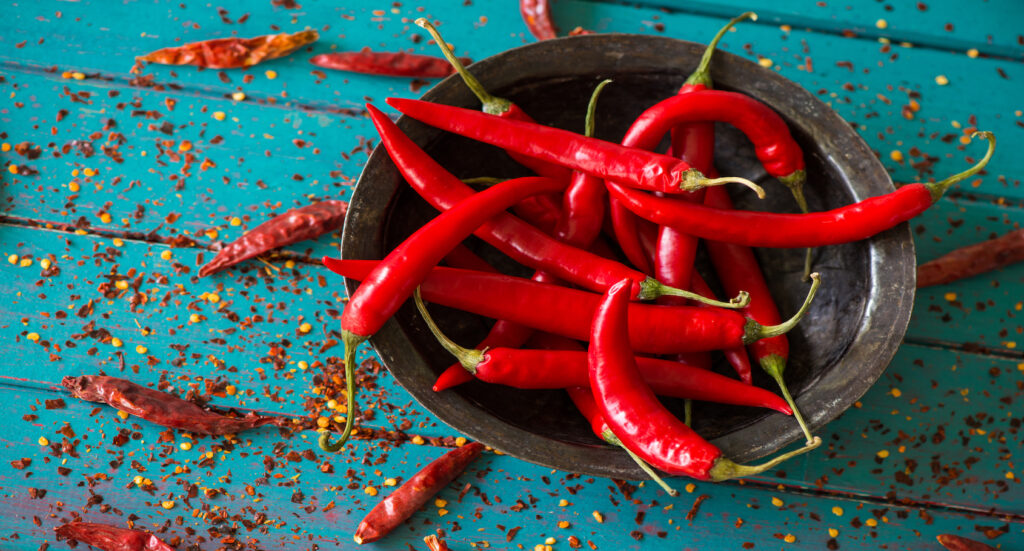If you’re a fan of bold flavors and vibrant dishes, you’ve likely encountered Chile de Arbol. This small, fiery pepper is a staple in many cuisines, particularly in Mexican cooking. Known for its intense heat and distinctive smoky flavor, it is more than just a spice—it’s a culinary powerhouse that can elevate your dishes from ordinary to extraordinary. Let’s explore why this pepper should be a must-have in every kitchen, and how you can use it to add a kick to your cooking.
What Is Chile de Arbol?
It also known as the Arbol pepper, is a small, thin, red chili pepper that packs a punch. Originating from Mexico, these peppers are part of the Capsicum annuum species, which also includes bell peppers and jalapeños. They are typically harvested when fully ripe, which gives them their vibrant red color and concentrated heat.
These peppers are usually dried and can be found in various forms, including whole, crushed, or powdered. The dried version is commonly used in cooking for its concentrated flavor and heat.
Flavor Profile and Heat Level
It is known for its sharp, smoky flavor and significant heat. On the Scoville scale, which measures the heat of peppers, it ranges from 15,000 to 30,000 Scoville Heat Units (SHU). For comparison, this is hotter than a jalapeño but milder than a habanero. The pepper’s smoky undertones and bright, tangy flavor make it a versatile ingredient that complements both spicy and savory dishes.
Culinary Uses of Chile de Arbol
1. Salsas and Sauces
Chile de Arbol is a fantastic addition to salsas and sauces, where its heat can be controlled to suit your taste. A traditional Mexican salsa made with it typically involves toasting the dried peppers to bring out their smoky flavor, then blending them with tomatoes, garlic, and onions. This salsa can be used as a dip for chips, a topping for tacos, or a flavorful addition to grilled meats.
Recipe: Basic Chile de Arbol Salsa
- Ingredients:
- 10 dried Chile de Arbol peppers
- 4 ripe tomatoes
- 2 cloves garlic
- 1 small onion
- Salt to taste
- 1 tablespoon vegetable oil
- Instructions:
- Toast the peppers: In a dry skillet over medium heat, toast the Chile peppers until they become fragrant. Be careful not to burn them.
- Blend the ingredients: Place the toasted peppers, tomatoes, garlic, and onion into a blender. Blend until smooth.
- Cook the salsa: Heat vegetable oil in a saucepan over medium heat. Pour in the salsa and cook for 10-15 minutes, stirring occasionally, until the flavors meld and the salsa thickens.
- Season: Add salt to taste, and serve.
2. Spicy Marinades
For those who love a bit of heat, incorporating Chile into marinades can transform your meats and vegetables. The pepper’s smoky flavor pairs well with a variety of proteins, from chicken to beef. Try blending crushed Chile with garlic, lime juice, and spices for a marinade that packs a punch.
Recipe: Chile de Arbol Marinade
- Ingredients:
- 5 dried Chile de Arbol peppers
- 3 cloves garlic
- Juice of 2 limes
- 1/4 cup olive oil
- 1 teaspoon cumin
- Salt to taste
- Instructions:
- Prepare the peppers: Toast and crush the Arbol peppers.
- Combine ingredients: In a bowl, mix the crushed peppers, garlic, lime juice, olive oil, cumin, and salt.
- Marinate: Use the marinade to coat your choice of meat or vegetables, and let it sit for at least 1 hour before cooking.
3. Soups and Stews
Adding Chile de Arbol to soups and stews can enhance their depth of flavor and heat. Whether you’re making a classic tortilla soup or a hearty beef stew, the pepper’s smoky and spicy characteristics will infuse the dish with a rich, complex flavor.
Recipe: Chile de Arbol Beef Stew
- Ingredients:
- 5 dried Chile de Arbol peppers
- 2 pounds beef stew meat
- 4 cups beef broth
- 1 onion, chopped
- 2 cloves garlic, minced
- 2 carrots, sliced
- 2 potatoes, cubed
- 1 teaspoon paprika
- Salt and pepper to taste
- Instructions:
- Toast and blend peppers: Toast the Arbol peppers and blend into a powder.
- Cook the beef: In a large pot, brown the beef stew meat on all sides.
- Add vegetables and seasonings: Add onion, garlic, carrots, and potatoes to the pot. Stir in the paprika, salt, and pepper.
- Simmer: Pour in the beef broth and Chile de Arbol powder. Bring to a boil, then reduce heat and let simmer for 1.5 to 2 hours until the meat is tender and the flavors are well combined.
4. Chili and Rubs
For chili enthusiasts, adding Arbol to your chili recipe can take it to the next level. The pepper’s heat and smokiness add complexity to the dish. Additionally, Chile de Arbol can be used as a component in rubs for grilled meats, enhancing the flavor profile with its spicy kick.
Recipe: Chile de Arbol Rub
- Ingredients:
- 3 tablespoons crushed Chile de Arbol
- 2 tablespoons brown sugar
- 1 tablespoon paprika
- 1 teaspoon garlic powder
- 1 teaspoon onion powder
- 1/2 teaspoon salt
- Instructions:
- Mix ingredients: Combine all the ingredients in a bowl.
- Apply the rub: Rub the mixture onto your choice of meat before grilling or roasting.
Storing and Handling Chile de Arbol
It should be stored in a cool, dry place, away from direct sunlight. When kept in an airtight container, dried Arbol can last for several months. If you prefer using them fresh, you can freeze them to extend their shelf life. Always handle dried Arbol with care, and be cautious of their heat when processing or cooking.
Conclusion
Chile de Arbol is more than just a spicy ingredient; it’s a versatile and flavorful addition to any kitchen. From salsas and marinades to soups and stews, this pepper can elevate a wide range of dishes with its distinctive heat and smokiness. Embrace the bold flavors of it and add this dynamic ingredient to your culinary repertoire. Whether you’re a spice aficionado or simply looking to try something new, it offers a delicious way to enhance your meals.







